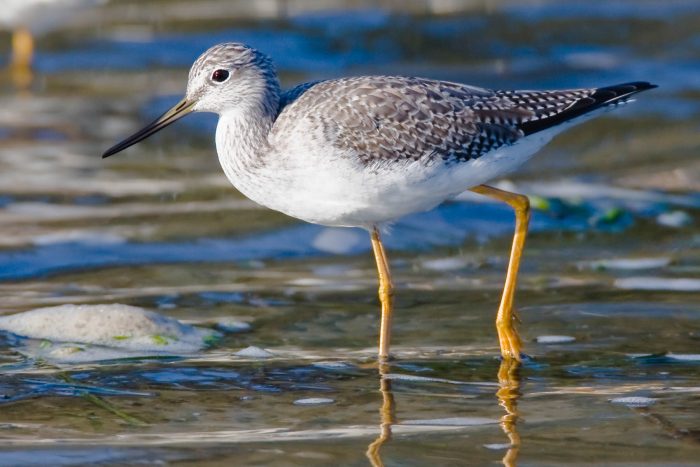Greater Yellowlegs
Tringa melanoleuca
The greater yellowlegs is a slender shorebird with a long, upturned bill and distinctive yellow or orange legs.
This section shows one large critter image at a time. Use the thumbnails that follow to select a specific image to display here.

This gallery contains a grid of small thumbnails. Selecting a thumbnail will change the main image in the preceding section.
Appearance
The greater yellowlegs is a medium-sized, slender shorebird that measures about 14 inches long. Its long bill is slightly upturned and measures about one and a half times the length of its head. It has long legs that are yellow to orange in color. Its back is brown and checkered with white, its neck and breast are white with brownish gray streaks, and its belly and rump are white. Its tail is white and crossed with thin black bars.
Feeding
The greater yellowlegs feeds during day and at night in shallows and mud flats, moving head in side-to-side or sweeping motion while seeking insect larvae, worms, snails, shrimp, small fish and frogs. It also probes aquatic vegetation to dislodge hidden fish. It swallows prey whole, headfirst.
Flight
The greater yellowlegs has a strong, swift flight and migrates in groups.
Voice
The loud, clear call of the greater yellowlegs consists of three descending notes, a whew-whew-whew or tew-tew-tew. Call variations include alarm, breeding, take-off, landing and migratory calls, as well as conversational murmuring.
Reproduction and life cycle
During courtship, a male will run in circles around a female and pose while quivering its upheld wings. Pairs are thought to mate for life and take joint care of young. Nests are made on the ground in a shallow scrape or depression in moss or peat.
Nests are lined with dead leaves, lichens, grasses and short, thin twigs. Female lays one brood per season, consisting of three or four spotted eggs in a clutch. Incubation period lasts 23 days; chicks take 18 to 20 days to fledge.
Did you know?
- Yellowlegs have also been called "tattlers," because they would raise a noisy alarm when bird hunters were near. Although shorebirds are now protected from hunting, yellowlegs may annoy birders by spooking other shorebirds with their alarm calls.
Sources and additional information
- Life in the Chesapeake Bay by Alice Jane Lippson and Robert L. Lippson
- Chesapeake Bay: Nature of the Estuary, A Field Guide by Christopher P. White
- Tringa melanoleuca – University of Michigan Museum of Zoology
- Greater Yellowlegs – Cornell Lab of Ornithology
- Greater Yellowlegs – NatureWorks
